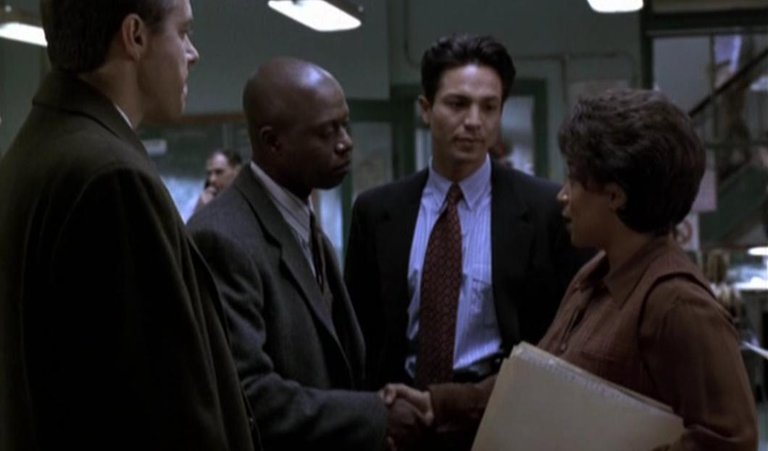Television Review: Charm City (Law & Order, S6X13, 1996)

Charm City (S06E13)
Airdate: 7 February 1996
Written by: Michael G. Chernuchin & Jorge Zamacona
Directed by: Edwin Sherin
Running Time: 47 minutes
One of the most frustrating quirks of 1990s American network television was the proliferation of multi-part crossovers between shows, a ratings-driven strategy that often resulted in tonal whiplash. These episodes, while clever in theory—luring fans of one programme to watch another—frequently exposed the absurdity of forcing divergent styles and casts into a single narrative. Law & Order and Homicide: Life on the Street, both police procedurals, were prime examples of this misfire. While Law & Order thrived on brisk, formulaic storytelling and courtroom theatrics, Homicide was a grittier, character-driven exploration of urban policing. Their 1996 crossover, Charm City, epitomised the pitfalls of such collaborations: clunky plotting, forced character interactions, and a sense that the networks cared more about ratings than narrative cohesion.
The Law & Order and Homicide crossovers began inauspiciously. In 1995’s Homicide episode Law & Disorder, NYPD detective Mike Logan (Chris Noth) briefly appeared in Baltimore, extraditing a suspect—a fleeting nod to cross-jurisdictional teamwork. Charm City, however, aimed for grander scale, unfolding across two episodes (the first on Law & Order, the second on Homicide) to explore a sprawling plot involving both cities. This ambition, however, only highlighted the shows’ fundamental differences: Law & Order’s procedural rigidity clashed with Homicide’s slow-burn realism, resulting in a hybrid that felt neither one nor the other.
Charm City opens with a nightmare scenario: a subway gas attack in New York kills over twenty people, predominantly Black victims. Detectives Lennie Briscoe (Jerry Orbach) and Rey Curtis (Tammy Lauren) trace the suspect to Brian Egan (Kevin Geer), a Baltimore native with access to chemicals. The plot thickens when Baltimore detectives Pembleton (Andre Braugher) and Bayliss (Kyle Secor) link Egan to a prior church bombing in their city. Egan confesses to Pembleton but retracts his statement, forcing District Attorney Jack McCoy (Sam Waterston) to secure a conviction in a racially charged trial. The episode concludes with a last-minute twist: Egan agrees to cooperate, implicating an unnamed mastermind—a cliffhanger shoehorned in to justify the Homicide follow-up.
The script, penned by Michael Chernuchin and Jorge Zamacona, leans heavily on real-world inspiration: the Tokyo subway sarin attack (1995) and the 1963 Birmingham church bombing. Yet, instead of nuanced exploration, the episode reduces terrorism to a white supremacist villain—a trope convenient in the post-Oklahoma City bombing climate but executed with little depth. The lack of federal involvement in a case this severe strains credulity, while jurisdictional squabbles between detectives feel contrived, existing solely to manufacture drama.
While the episode’s premise draws from pivotal historical events, its execution prioritises formula over realism. The white supremacist antagonist—a staple of 1990s Hollywood thrillers—serves as a simplistic villain, his ideology barely explored beyond generic rants. The trial’s relocation to a predominantly white jury, meant to highlight racial tensions, plays like a tired courtroom trope. Even the connection to the Birmingham bombing feels tokenistic, reduced to a plot point rather than a thematic anchor.
The script’s reliance on Law & Order’s “ripped from the headlines” ethos further undermines its ambitions. The rapid resolution of Egan’s trial, with McCoy’s slick courtroom theatrics sealing the deal, sidesteps the moral complexities of a death penalty case. Meanwhile, Bayliss’s subplot—a fleeting flirtation with Claire Kincaid (Jill Hennessy)—adds nothing beyond a perfunctory nod to the Law & Order cast, underscoring how the crossover prioritised franchise branding over character development.
The episode’s final act epitomises its flaws. A rushed revelation that Egan’s confession implicates a shadowy “mastermind” feels less like a narrative payoff and more like a desperate ploy to segue into the Homicide follow-up. This contrivance—a hallmark of Law & Order’s “tease-and-resolve” structure—grates against Homicide’s patient, detail-oriented storytelling. For viewers expecting the latter show’s depth, Charm City’s procedural shorthand feels tone-deaf.
To fans of Homicide: Life on the Street, Charm City is a bitter pill. The series had earned acclaim for eschewing Law & Order’s procedural tropes in favour of nuanced character studies and systemic critiques. Here, however, it’s reduced to a backdrop for Law & Order’s plot mechanics. Pembleton and Bayliss, usually anchors of the show’s grounded realism, are sidelined into reactive roles, their expertise neutered by the crossover’s constraints. The episode’s reliance on racial politics as a plot device—rather than a thematic exploration—feels especially jarring given Homicide’s earlier, more incisive takes on institutional racism.
Charm City is as a relic of 1990s network thinking: prioritise ratings over coherence, and franchise synergy over artistic integrity. While it occasionally nods to the real-world horrors it references, its narrative is hamstrung by formula, cliché, and the inherent tensions of merging two distinct visions. For Homicide fans, it’s a reminder of what their show avoided; for Law & Order devotees, it’s a competent but unmemorable entry in a franchise known for better. The crossover’s legacy lies not in its storytelling, but as a cautionary tale of TV’s relentless pursuit of cross-platform spectacle—no matter the cost to quality.
RATING: 4/10 (+)
Blog in Croatian https://draxblog.com
Blog in English https://draxreview.wordpress.com/
InLeo blog https://inleo.io/@drax.leo
Hiveonboard: https://hiveonboard.com?ref=drax
Rising Star game: https://www.risingstargame.com?referrer=drax
1Inch: https://1inch.exchange/#/r/0x83823d8CCB74F828148258BB4457642124b1328e
BTC donations: 1EWxiMiP6iiG9rger3NuUSd6HByaxQWafG
ETH donations: 0xB305F144323b99e6f8b1d66f5D7DE78B498C32A7
BCH donations: qpvxw0jax79lhmvlgcldkzpqanf03r9cjv8y6gtmk9